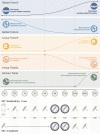Transcriptomic analysis reveals pronounced changes in gene expression due to sub-lethal pyrethroid exposure and ageing in insecticide resistance Anopheles coluzzii
- PMID: 33971808
- PMCID: PMC8111724
- DOI: 10.1186/s12864-021-07646-7
Transcriptomic analysis reveals pronounced changes in gene expression due to sub-lethal pyrethroid exposure and ageing in insecticide resistance Anopheles coluzzii
Abstract
Background: Malaria control is heavily reliant on the use of insecticides that target and kill the adult female Anopheline vector. The intensive use of insecticides of the pyrethroid class has led to widespread resistance in mosquito populations. The intensity of pyrethroid resistance in some settings in Africa means mosquitoes can contact bednets treated with this insecticide class multiple times with minimal mortality effects. Furthermore, both ageing and diel cycle have been shown to have large impacts on the resistance phenotype. Together, these traits may affect other aspects of vector biology controlling the vectorial capacity or fitness of the mosquito.
Results: Here we show that sublethal exposure of a highly resistant Anopheles coluzzii population originally from Burkina Faso to the pyrethroid deltamethrin results in large and sustained changes to transcript expression. We identify five clear patterns in the data showing changes to transcripts relating to: DNA repair, respiration, translation, behaviour and oxioreductase processes. Further, we highlight differential regulation of transcripts from detoxification families previously linked with insecticide resistance, in addition to clear down-regulation of the oxidative phosphorylation pathway both indicative of changes in metabolism post-exposure. Finally, we show that both ageing and diel cycle have major effects on known insecticide resistance related transcripts.
Conclusion: Sub-lethal pyrethroid exposure, ageing and the diel cycle results in large-scale changes in the transcriptome of the major malaria vector Anopheles coluzzii. Our data strongly supports further phenotypic studies on how transcriptional changes such as reduced expression of the oxidative phosphorylation pathway or pyrethroid induced changes to redox state might impact key mosquito traits, such as vectorial capacity and life history traits.
Keywords: Anopheles coluzzii; Insecticide resistance; Pyrethroids; Sub-lethal exposure; Transcriptome.
Conflict of interest statement
The authors declare they have no competing interests.
Figures




Similar articles
-
Anopheles gambiae populations from Burkina Faso show minimal delayed mortality after exposure to insecticide-treated nets.Parasit Vectors. 2020 Jan 10;13(1):17. doi: 10.1186/s13071-019-3872-2. Parasit Vectors. 2020. PMID: 31924276 Free PMC article.
-
Targeted application of an organophosphate-based paint applied on windows and doors against Anopheles coluzzii resistant to pyrethroids under real life conditions in Vallée du Kou, Burkina Faso (West Africa).Malar J. 2018 Apr 2;17(1):136. doi: 10.1186/s12936-018-2273-x. Malar J. 2018. PMID: 29609597 Free PMC article.
-
Pilot study on the combination of an organophosphate-based insecticide paint and pyrethroid-treated long lasting nets against pyrethroid resistant malaria vectors in Burkina Faso.Acta Trop. 2015 Aug;148:162-9. doi: 10.1016/j.actatropica.2015.04.010. Epub 2015 May 7. Acta Trop. 2015. PMID: 25959771
-
Piperonyl butoxide (PBO) combined with pyrethroids in insecticide-treated nets to prevent malaria in Africa.Cochrane Database Syst Rev. 2018 Nov 29;11(11):CD012776. doi: 10.1002/14651858.CD012776.pub2. Cochrane Database Syst Rev. 2018. Update in: Cochrane Database Syst Rev. 2021 May 24;5:CD012776. doi: 10.1002/14651858.CD012776.pub3. PMID: 30488945 Free PMC article. Updated.
-
Piperonyl butoxide (PBO) combined with pyrethroids in insecticide-treated nets to prevent malaria in Africa.Cochrane Database Syst Rev. 2021 May 24;5(5):CD012776. doi: 10.1002/14651858.CD012776.pub3. Cochrane Database Syst Rev. 2021. PMID: 34027998 Free PMC article.
Cited by
-
Multi-insecticide resistant malaria vectors in the field remain susceptible to malathion, despite the presence of Ace1 point mutations.PLoS Genet. 2022 Feb 10;18(2):e1009963. doi: 10.1371/journal.pgen.1009963. eCollection 2022 Feb. PLoS Genet. 2022. PMID: 35143477 Free PMC article.
-
Aqueous exposure to a pyrethroid pesticide results in behavioural effects in early life stage sturgeon.Conserv Physiol. 2025 Jul 30;13(1):coaf055. doi: 10.1093/conphys/coaf055. eCollection 2025. Conserv Physiol. 2025. PMID: 40741373 Free PMC article.
-
The effect of temperature on dengue virus transmission by Aedes mosquitoes.Front Cell Infect Microbiol. 2023 Sep 21;13:1242173. doi: 10.3389/fcimb.2023.1242173. eCollection 2023. Front Cell Infect Microbiol. 2023. PMID: 37808907 Free PMC article. Review.
-
Molecular response of Chironomus riparius to antibiotics.Curr Res Toxicol. 2025 May 18;8:100239. doi: 10.1016/j.crtox.2025.100239. eCollection 2025. Curr Res Toxicol. 2025. PMID: 40491715 Free PMC article.
-
Uridine diphosphate (UDP)-glycosyltransferases (UGTs) are associated with insecticide resistance in the major malaria vectors Anopheles gambiae s.l. and Anopheles funestus.Sci Rep. 2024 Aug 27;14(1):19821. doi: 10.1038/s41598-024-70713-y. Sci Rep. 2024. PMID: 39191827 Free PMC article.
References
-
- Bhatt S, Weiss DJ, Cameron E, Bisanzio D, Mappin B, Dalrymple U, Battle KE, Moyes CL, Henry A, Eckhoff PA, Wenger EA, Briët O, Penny MA, Smith TA, Bennett A, Yukich J, Eisele TP, Griffin JT, Fergus CA, Lynch M, Lindgren F, Cohen JM, Murray CLJ, Smith DL, Hay SI, Cibulskis RE, Gething PW. The effect of malaria control on Plasmodium falciparum in Africa between 2000 and 2015. Nature. 2015;526(7572):207–211. doi: 10.1038/nature15535. - DOI - PMC - PubMed
-
- World Malaria Report. 2019. https://www.who.int/publications/i/item/9789240015791.
-
- Staedke SG, Gonahasa S, Dorsey G, Kamya MR, Maiteki-Sebuguzi C, Lynd A, Katureebe A, Kyohere M, Mutungi P, Kigozi SP, Opigo J, Hemingway J, Donnelly MJ. Effect of long-lasting insecticidal nets with and without piperonyl butoxide on malaria indicators in Uganda (LLINEUP): a pragmatic, cluster-randomised trial embedded in a national LLIN distribution campaign. Lancet. 2020;395(10232):1292–1303. doi: 10.1016/S0140-6736(20)30214-2. - DOI - PMC - PubMed
-
- Protopopoff N, Mosha JF, Lukole E, Charlwood JD, Wright A, Mwalimu CD, Manjurano A, Mosha FW, Kisinza W, Kleinschmidt I, Rowland M. Effectiveness of a long-lasting piperonyl butoxide-treated insecticidal net and indoor residual spray interventions, separately and together, against malaria transmitted by pyrethroid-resistant mosquitoes: a cluster, randomised controlled, two-by-two fact. Lancet. 2018;391(10130):1577–1588. doi: 10.1016/S0140-6736(18)30427-6. - DOI - PMC - PubMed
MeSH terms
Substances
Grants and funding
LinkOut - more resources
Full Text Sources
Other Literature Sources
Medical

